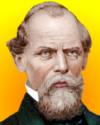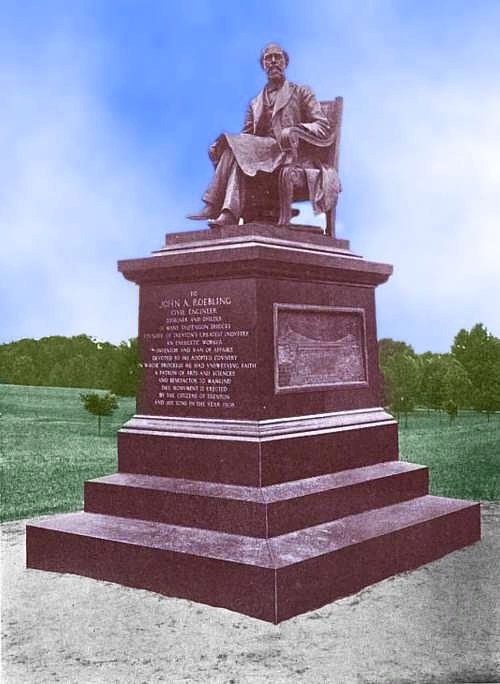 (source)
(source)
|
John A. Roebling
(12 Jun 1806 - 22 Jul 1869)
who pioneered the design and construction of suspension bridges, including a railroad suspension bridge over the Niagara River and his most famous Brooklyn Bridge, New York.
|
John A. Roebling
An Account of the Ceremonies at the Unveiling of a Monument to His Memory (1908)
[p.3] While many monuments have been erected in honor of those who have achieved distinction in statecraft, who have led victorious armies upon hard fought battlefields, or who by the exercise of exceptional literary gifts have appealed to world wide sympathies and affections, the sculptor’s art has been seldom employed to commemorate the virtues of men whose lives were spent in scientific and industrial pursuits.
It has been said that a great engineer dealing with material things, and bending them to his will, leaves behind him monuments in the works built upon his designs. This is true, but while an imposing structure may give evidence of the genius of the builder, it suggests but little of the man himself, and it is therefore proper that those who deem him worthy, should give expression in material form to the esteem in which they hold his memory.
To the small number of monuments erected in honor of eminent engineers, there has recently been added, at Trenton, N. J., a statue of John A. Roebling. Mr. Roebling was not a native of Trenton, nor of the country in which the greater part of his life was spent. Yet so important was his work and so strong the impression left by his personality, it is not strange that the people of his adopted city desired to place in their principal park, a statue portraying the man as he looked in the prime of his active life.
A committee of citizens took the matter in hand and solicited popular subscriptions which resulted in contributions from a large number of the people of Trenton, who had either known Mr. Roebling or appreciated the benefit of his services to their community.
[p.4] The monument was designed by Mr. William Couper, of New York, under whose direction there was produced a striking likeness of the great engineer. It was unveiled on June 30th, 1908, in the presence of over 15,000 people, among whom were the Governor of New Jersey, the representatives of the State in the United States Senate and a number of other distinguished guests.
Throughout the city of Trenton there was a general display of flags, the occasion being officially recognized, locally, by the closing of the City Hall and Court House at noon and the attendance of the City and County officials in a body.
The City of Mülhausen, Germany, the birthplace of Mr. Roebling, sent an artistic copper wreath as its tribute to his memory.
Notable features of the dedication ceremonies were a concert by Winkler’s Second Regiment Band, singing by the United German Singing Societies of Trenton under the direction of Dr. Carl Hoffman, and addresses by Hon. Edward C. Stokes, former Governor of New Jersey, and Mr. Henry D. Estabrook, of New York, General Counsel for the Western Union Telegraph Company.
Prior to the unveiling of the monument, 6500 men, employees of the industry founded by John A. Roebling, and since his death conducted by his sons, marched from the works, through the streets of Trenton to Cadwalader Park. It is interesting to note in this connection that in the year 1908 occurs the sixtieth anniversary of the removal by Mr. Roebling of his plant to Trenton from Saxonburg, Pa., where eight years before he had begun the manufacture of wire rope.
Mr. Roebling was the first to make wire rope in this country, and, as the market developed, he found that it could not be conveniently supplied from the location of the [p.5] original factory. It was, therefore, decided to move to Trenton, where preparations were made to manufacture wire rope in larger quantities than could be produced with the limited facilities employed at Saxonburg. As an aid to this, there was soon added to the rope shop a mill for drawing wire, from which wire was supplied to the trade as well as for stranding into rope.
Wire has been made from bars of metal for many centuries, but sixty years ago it was far from being the important product it has since become, and there was then little to indicate the many uses to which in a few years it would be applied. Mr. Roebling, by his work at Saxonburg had shown the merit of wire cables, but their use was still confined within comparatively narrow limits, and there was nothing to correspond with the present demand for wire for mechanical purposes.
When the factory was built at Trenton, there were no elevators raised and lowered by wire ropes in lofty buildings, and modern methods of mining, quarrying and lumbering, depending upon the operation of wire cables were unknown. The telegraph was in use, but a few miles of wire were sufficient to carry the occasional messages for which the mails were thought too slow, and years were yet to pass before wire cables should lie upon the ocean’s bed, flashing the news of widely separated continents. No human voice had ever sent its vibrations across miles of space, and the millions of pounds of metal now annually transformed into threads of wire to transmit electrical energy then lay buried in unsought, undiscovered mines.
The latter half of the nineteenth century was destined to be marked by a rapid development of the resources of the country, and by a progress in mechanical arts greater than the world had ever known before.
[p.6] This development and progress called for the exercise with ever broadening scope of the talents of the inventor and engineer, and such talents, combined with the judgement of a practical business man, were possessed in a high degree by the wire rope maker of Trenton.
He was not the only manufacturer of his time who had added to the capacity of his factory. Old manufacturing establishments were being enlarged; new ones were springing into existence, and with the growth of the manufacturing industry there came a demand for an increased supply of fuel, and the need of improved methods of mining and transportation.
Rich veins of coal were located in the mountains, the strata running far above the valley roads. The demand for additional fuel could be supplied by the development of these mines, but the transportation of coal to convenient shipping points presented a difficult problem for solution. This Mr. Roebling helped to solve, by equipping with wire rope inclined planes, extending along the mountain side from the opening of the mine to the valley below.
As an aid in building suspension bridges, he designed endless wire rope cableways, which, continuously moving upon wheels located at each end of a bridge span, carried across wires to form the supporting cables. It was a short step from these to cableways, spanning ravines and mountain gorges, carrying coal and other minerals where old methods of transportation would have been impracticable.
Each successful application of his product enhanced the reputation of the wire rope manufacturer and increased the demand for his services.
The year following his settlement at Trenton, gold was discovered in California, awakening the country to an appreciation of the possibilities of the West, and providing [p.7] an incentive for the investment of capital in the extension of Eastern railways. But rivers must be spanned to carry their rails, and transportation companies, operating lines of steamboats upon important waterways, bitterly opposed plans to build railroad bridges with piers threatening to obstruct navigation.
If the Niagara river could be bridged there would be no conflict with steamship lines, but the natural conditions which prevented navigation made impracticable the construction of piers in the stream. Prominent engineers who inspected the site expressed the opinion that a bridge could not be built, and it seemed as though the railway must halt in its course toward the West.
The one man of the time to present a solution of the problem was the pioneer wire rope manufacturer, whose designs of suspension bridges had been met with ridicule and opposition.
By force of argument and logic of mathematical demonstration, he gained converts to his belief that he could safely extend the railway across Niagara. His design was finally adopted, and on March 16, 1855, a span, 800 feet in length, carried by wire cables 245 feet above the whirlpool rapids, supported the first railroad train to cross a suspension bridge.
The following year witnessed the beginning of a span 200 feet longer than that at Niagara, to cross the Ohio river at Cincinnati, and then Mr. Roebling proposed what was to be the crowning achievement of his career, a plan to connect the cities of New York and Brooklyn by a bridge with a river span of 1600 feet, supported by cables, placed high enough above the water to enable ships with their towering masts to sail beneath. This project was advanced in the fifties, but it was not until ten years later that the plan was adopted.
[p.8] The designer of the Brooklyn bridge did not live to see its completion, losing his life July 22nd, 1869, as the result of an accident at the very inception of the work. The bridge, completed under the direction of his son, Washington, was opened for traffic in 1883 and has been continuously in use ever since.
John A. Roebling came to America a stranger to its life and customs, without influential friends and with little capital other than character, energy, and courage. He began the manufacture of an unknown article, for which he created a market, aiding in so doing the development of the nation’s resources and laying the foundation of one of the world’s great industries. He met a condition arising from the growth of his adopted country, by proposing to carry new highways across rivers upon bridges, the like of which had not been known before.
There arose about him a chorus of protest, voiced by engineers more eminent than he, who denounced his plan as visionary and impracticable. With courage undaunted, a persistence not to be repelled, he insisted that he had discovered a principle of mechanics worthy of acceptance and silenced his critics by building those great bridges which stand as beautiful and imposing monuments to his memory.
To these monuments there has been added the statue erected at Trenton, the tribute of the people of the city where he lived and wrought so well.
The following pages contain the programme of the ceremonies at the dedication of the monument, the speakers’ addresses, biographical sketches of the memorial committee and comments of the press upon the occasion.
- 12 Jun - short biography, births, deaths and events on date of Roebling's birth.
- Builders of the Bridge: The Story of John Roebling and His Son, by David Barnard Steinman. - book suggestion.





